Night Walks in Kibale Forest: A Unique Experience
Entering the Forest After Dark
While Kibale National Park is globally celebrated for its daytime chimpanzee trekking and diverse primate population, the forest takes on a dramatically different character when night falls. Night walks in Kibale offer a rare opportunity to explore the forest beyond daylight, unveiling the secretive lives of nocturnal wildlife and the subtle rhythms of a rainforest ecosystem. As darkness descends, the forest becomes alive with sounds, movements, and phenomena that remain hidden during the day. Shadows flicker among dense foliage, insects hum in intricate patterns, and eyes glint in the beam of a headlamp, revealing an entirely new dimension of biodiversity.
Night walks in Kibale are not merely recreational; they are an immersive form of ecological education, allowing visitors to experience the forest’s nocturnal dynamics, predator-prey interactions, and behavioral adaptations of wildlife. The adventure demands careful preparation, awareness of safety protocols, and a heightened sensitivity to environmental cues. Ethical engagement and minimal disturbance are paramount, ensuring that nocturnal species are observed without interference, and the forest remains a sanctuary for both wildlife and human visitors.
This guide explores the uniqueness of night walks in Kibale Forest, highlighting wildlife encounters, ecological insights, seasonal considerations, technical guidance, and the transformative experience of traversing a tropical rainforest under the cover of darkness.
The Nocturnal Forest of Kibale
Understanding Nocturnal Dynamics
Kibale Forest transforms after sunset, with diurnal creatures resting and nocturnal species emerging. Animals such as galagos (bush babies), pottos, owls, civets, genets, and porcupines become active, displaying behaviors rarely observed during daylight hours. The forest floor becomes a stage for small mammal foraging, while arboreal layers reveal nocturnal primates navigating the canopy in search of fruits and insects.
Sounds dominate the night. The calls of owls, insect choruses, and the rustle of small mammals convey a vibrant, unseen life. Night walks require careful listening and observation, as many species are detected more by sound and movement than by sight. Guides play a crucial role, using their expertise to locate, identify, and interpret these nocturnal signals, enriching both ecological understanding and photographic opportunities.
Ecological Significance
The nocturnal activity of Kibale’s fauna demonstrates adaptive strategies, predator-prey interactions, and ecological niches that maintain the forest’s biodiversity. Observing nocturnal species highlights evolutionary adaptations such as enhanced vision, echolocation, stealth, and dietary specialization. Night walks provide firsthand insight into these adaptations, allowing visitors to witness behaviors and interactions that complement daytime observations of primates, birds, and larger mammals.
Planning a Night Walk
Timing and Duration
Night walks are typically conducted after sunset, with sessions lasting between two and three hours. Optimal timing varies seasonally, as sunset occurs earlier during certain months, allowing flexibility in planning subsequent activities or return to lodges. Early evening walks often provide opportunities to observe the emergence of nocturnal mammals, while later hours reveal heightened insect and amphibian activity.
Safety Considerations
Safety is paramount during night walks. Trails are navigated with headlamps or torches, and guides maintain vigilance for wildlife, terrain hazards, and orientation. Participants are instructed on appropriate behavior, including quiet movement, minimal use of flash photography, and maintaining safe distances from animals. Emergency protocols and communication equipment are always in place, ensuring visitor security while allowing an immersive forest experience.
Equipment and Preparation
Visitors are encouraged to wear lightweight, long-sleeved clothing, closed shoes, and insect repellents to protect against forest insects and environmental conditions. Cameras with low-light capability, tripods, and red-filtered lights are recommended for photographers seeking to capture nocturnal scenes without disturbing wildlife. Binoculars with night-vision or low-light enhancement can also enrich observation, allowing close monitoring of elusive species.
Wildlife Encounters During Night Walks
Nocturnal Primates
While Kibale’s chimpanzees are diurnal, nocturnal primates such as the potto and bush baby reveal remarkable adaptations. Bush babies exhibit rapid, agile movements and large eyes adapted for low-light vision, often observed leaping between branches or calling in response to distant sounds. Pottos, with their slow and deliberate movements, demonstrate stealthy nocturnal navigation that contrasts sharply with daytime primate behavior. Observing these species underscores the diversity of primate adaptations within the same forest ecosystem.
Small Mammals and Rodents
Small mammals such as civets, genets, porcupines, and giant forest rats emerge to forage. Their presence is often detected through rustling leaves, reflective eyes, or subtle scent trails. These animals play critical roles in seed dispersal, pest control, and maintaining forest balance, and night walks provide insight into their ecological functions. Guides interpret behaviors, helping visitors understand feeding strategies, territoriality, and nocturnal survival mechanisms.
Insects and Amphibians
Insects dominate the auditory and visual landscape at night. Cicadas, katydids, beetles, and moths create a complex soundscape and movement pattern, while bioluminescent species may add ephemeral glows to the forest floor. Amphibians, including tree frogs and toads, vocalize in choruses that reflect environmental conditions, mating cycles, and predator-prey dynamics. Night walks offer a rare opportunity to observe these species in their natural behaviors, often unnoticed during daytime excursions.
Birds and Reptiles
Certain bird species, particularly owls and nightjars, are active and can be observed calling, hunting, or perching silently. Reptiles such as nocturnal geckos and snakes navigate the forest under the cover of darkness, with subtle movements and reflective eye-shine revealing their presence. Night walks allow for a comprehensive understanding of ecological interactions across multiple taxa, highlighting the forest’s complexity and interconnectedness.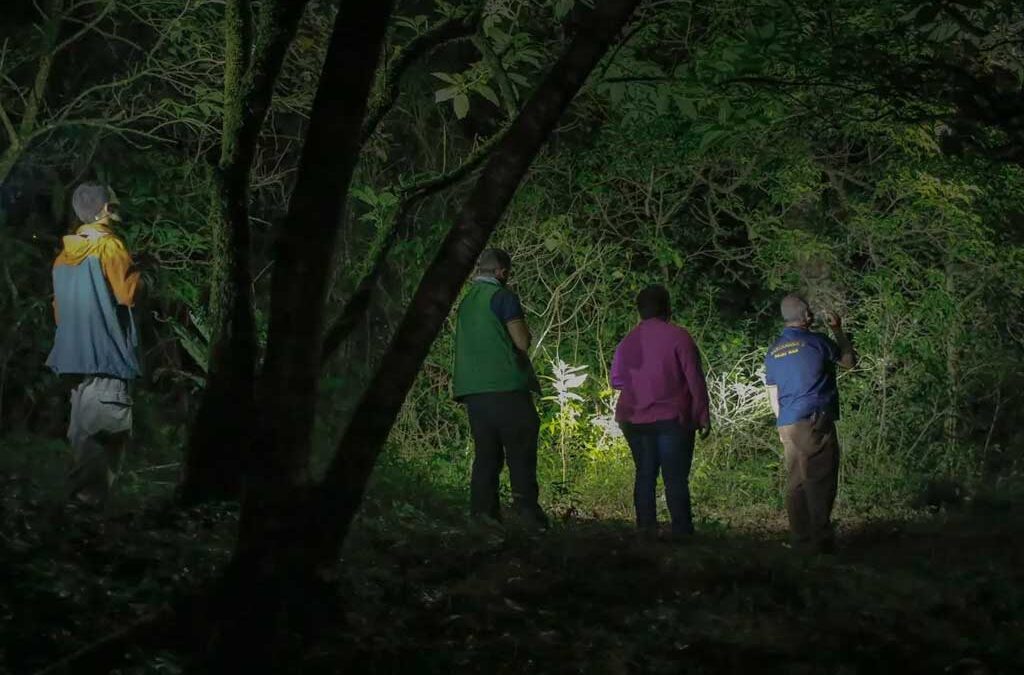
Ecological Insights from Night Walks
Predator-Prey Interactions
Observing nocturnal behaviors illuminates predator-prey dynamics rarely visible during the day. Small mammals, amphibians, and insects display vigilance, defensive adaptations, and avoidance strategies, while nocturnal predators such as owls, genets, and snakes engage in stealth hunting. Visitors witness these interactions firsthand, gaining an appreciation for the balance of ecological systems and the subtle choreography of survival.
Behavioral Adaptations
Night walks provide an opportunity to study behavioral adaptations to low-light conditions, including specialized vision, echolocation, nocturnal vocalizations, and arboreal navigation. Comparing nocturnal strategies with daytime behaviors enhances understanding of species ecology, energy allocation, and habitat utilization.
Environmental Awareness
Traversing the forest at night heightens awareness of microhabitats, forest structure, and environmental cues. The interplay of light, moisture, temperature, and sound informs species distribution, activity patterns, and ecological interactions. Visitors gain a deeper appreciation of the forest as a living system, shaped by both biotic and abiotic factors.
Photography and Observation Techniques
Low-Light Photography
Photographers are encouraged to employ techniques suited to low-light conditions, including high ISO settings, wide apertures, and slow shutter speeds, while minimizing disturbance to wildlife. Red-filtered lights, external flashes with diffusers, and tripods enhance image stability and quality. Compositional strategies focus on capturing eye reflections, silhouettes, movement, and textural contrasts, conveying the atmosphere and mystery of the nocturnal forest.
Behavioral Documentation
Night walks provide unique opportunities to document behavioral sequences, such as feeding, mating calls, and predator-prey interactions. Photographers and researchers are advised to maintain observational distance, reduce artificial light exposure, and focus on naturalistic documentation to ensure authenticity and ethical practice.
Seasonal and Environmental Considerations
Wet and Dry Seasons
Seasonal variations influence nocturnal activity. During the wet season, insect and amphibian activity peaks, while forest trails may be slippery and challenging. In the dry season, trails are more navigable, and nocturnal mammals are often concentrated around water sources, enhancing observation opportunities. Planning night walks in consideration of seasonal conditions maximizes both safety and wildlife encounters.
Weather Impacts
Rain, wind, and humidity affect nocturnal visibility and animal behavior. Walks are typically conducted under calm conditions to ensure both safety and quality observation. Guides adjust routes, timing, and duration according to weather, optimizing the experience while minimizing environmental impact.
Complementary Daytime Activities
Chimpanzee Tracking
Daytime chimpanzee tracking provides context for nocturnal experiences, allowing visitors to understand diurnal and nocturnal activity patterns, feeding ecology, and social behavior. Comparing observations enhances ecological comprehension and enriches storytelling through photography and guided interpretation.
Birdwatching and Nature Walks
Daytime birdwatching complements nocturnal insect and amphibian observations. Nature walks reveal forest structure, plant identification, and habitat diversity, providing a comprehensive understanding of forest dynamics across temporal scales.
Cultural Engagement
Community interactions near Kibale, including visits to Bakiga and Batwa villages, add a human dimension to nocturnal exploration. Traditional knowledge often informs nocturnal wildlife awareness, such as the tracking of forest animals or identification of edible plants, bridging ecological and cultural understanding.
Logistics and Preparation
Guides and Permits
Night walks require experienced guides familiar with nocturnal wildlife, forest trails, and safety protocols. Permits and park authorization ensure regulated access and adherence to conservation guidelines. Guide expertise is essential for maximizing observation opportunities and maintaining ethical standards.
Accommodation
Lodges near Kibale serve as bases for night walks, providing easy access to trailheads and pre-dawn departures. Facilities often include equipment storage, briefings, and photographic support, allowing visitors to balance comfort with immersive forest engagement.
Ethical Considerations
Minimizing Disturbance
Respecting wildlife and habitat is paramount. Minimal light use, quiet movement, and adherence to trails ensure that nocturnal species are observed without disruption. Ethical practices support long-term conservation objectives and enhance the authenticity of the experience.
Cultural Respect
Interactions with local communities during nighttime excursions, such as village visits or nocturnal cultural demonstrations, require consent, respect, and sensitivity. Collaborative engagement ensures that benefits are shared and traditions are preserved.
A Transformative Experience
Night walks in Kibale Forest offer a unique and immersive perspective of Uganda’s rainforest, revealing the hidden rhythms of nocturnal wildlife, the subtleties of ecological interactions, and the interplay of sound, light, and movement that defines the forest after dark. When combined with daytime chimpanzee tracking, birdwatching, and cultural engagement, these walks provide a holistic understanding of forest ecology and human-nature interconnections.
For travelers seeking an expertly guided, safe, and ethically responsible nocturnal safari experience, arrangements through WildHorn Africa are recommended. Their professional guidance ensures access to prime nocturnal observation areas, knowledgeable rangers, logistical coordination, and immersive experiences, transforming a night walk in Kibale into a memorable and educational adventure in Uganda’s tropical rainforest.

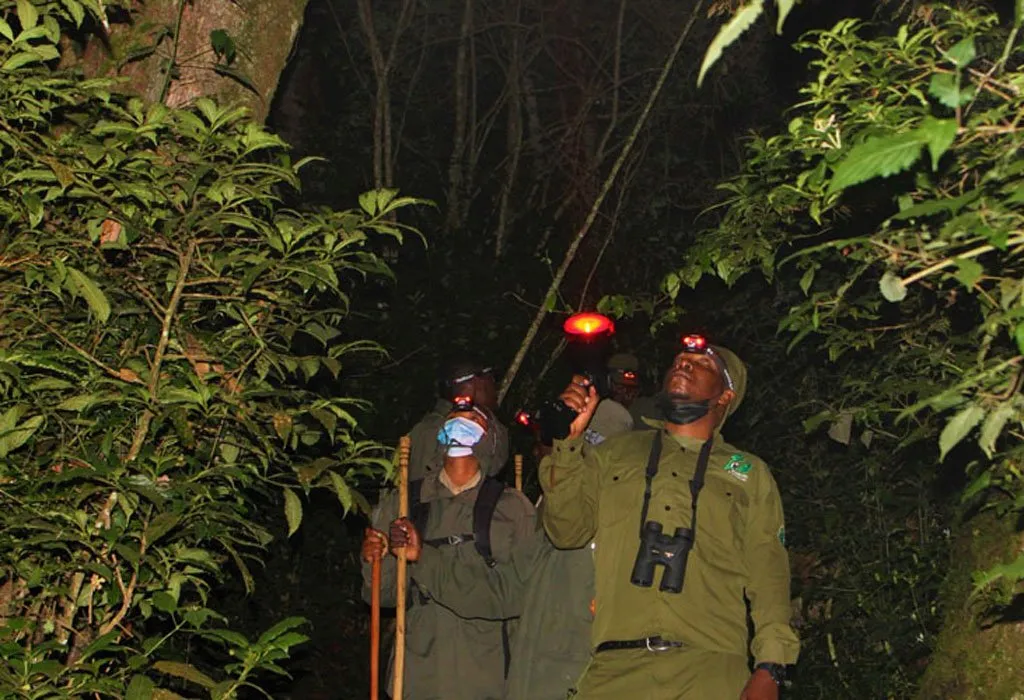
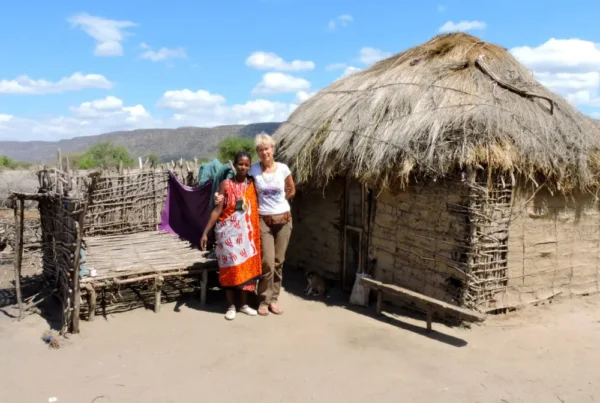
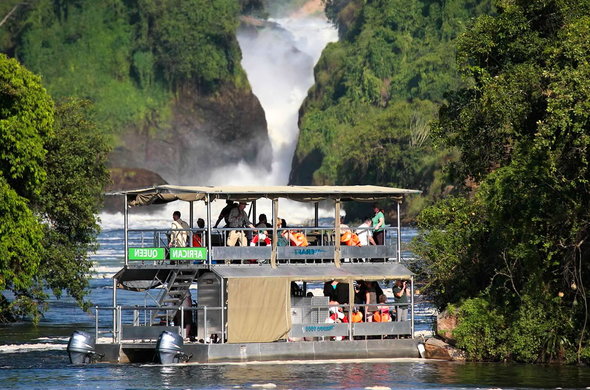
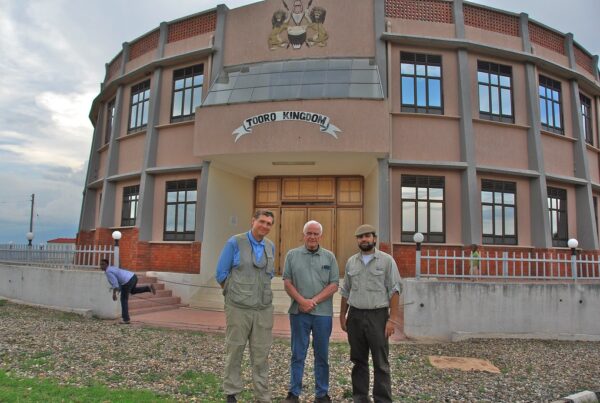
 WildHorn Africa – Authentic and unforgettable tours across Africa, guided by local experts who know the land, wildlife, and culture best.
WildHorn Africa – Authentic and unforgettable tours across Africa, guided by local experts who know the land, wildlife, and culture best.


